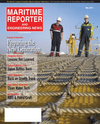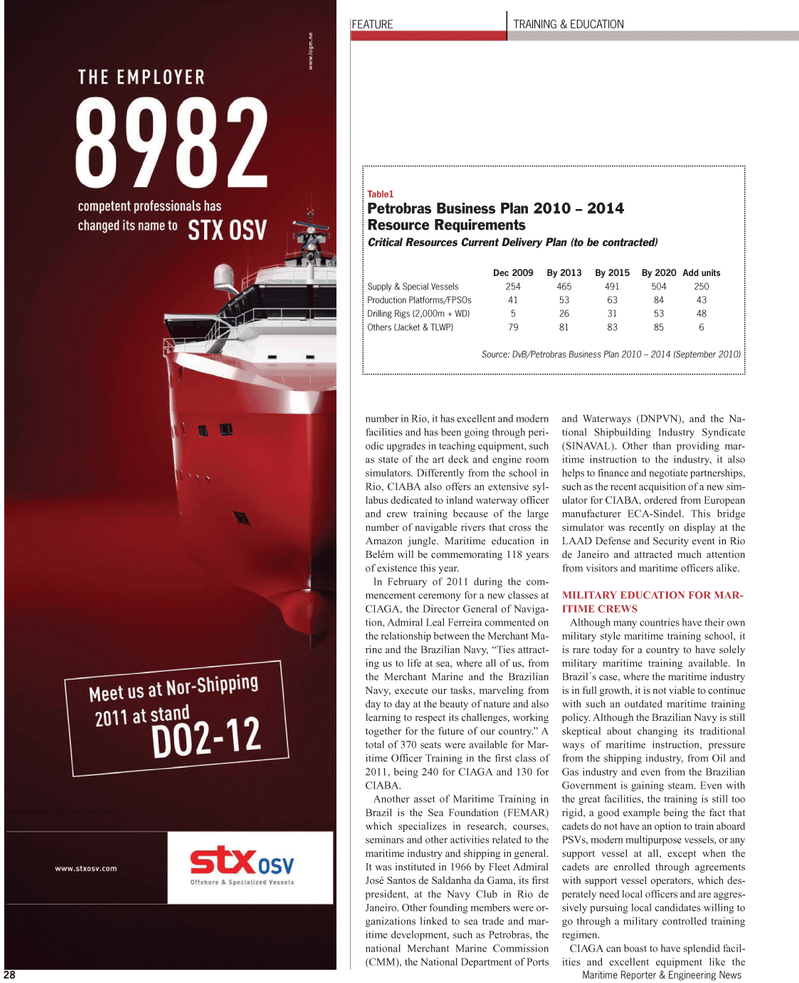
Page 28: of Maritime Reporter Magazine (May 2011)
Training & Education Edition
Read this page in Pdf, Flash or Html5 edition of May 2011 Maritime Reporter Magazine
28 Maritime Reporter & Engineering News number in Rio, it has excellent and modern facilities and has been going through peri- odic upgrades in teaching equipment, such as state of the art deck and engine room simulators. Differently from the school in
Rio, CIABA also offers an extensive syl- labus dedicated to inland waterway officer and crew training because of the large number of navigable rivers that cross the
Amazon jungle. Maritime education in
Belém will be commemorating 118 years of existence this year.
In February of 2011 during the com- mencement ceremony for a new classes at
CIAGA, the Director General of Naviga- tion, Admiral Leal Ferreira commented on the relationship between the Merchant Ma- rine and the Brazilian Navy, “Ties attract- ing us to life at sea, where all of us, from the Merchant Marine and the Brazilian
Navy, execute our tasks, marveling from day to day at the beauty of nature and also learning to respect its challenges, working together for the future of our country.” A total of 370 seats were available for Mar- itime Officer Training in the first class of 2011, being 240 for CIAGA and 130 for
CIABA.
Another asset of Maritime Training in
Brazil is the Sea Foundation (FEMAR) which specializes in research, courses, seminars and other activities related to the maritime industry and shipping in general.
It was instituted in 1966 by Fleet Admiral
José Santos de Saldanha da Gama, its first president, at the Navy Club in Rio de
Janeiro. Other founding members were or- ganizations linked to sea trade and mar- itime development, such as Petrobras, the national Merchant Marine Commission (CMM), the National Department of Ports and Waterways (DNPVN), and the Na- tional Shipbuilding Industry Syndicate (SINAVAL). Other than providing mar- itime instruction to the industry, it also helps to finance and negotiate partnerships, such as the recent acquisition of a new sim- ulator for CIABA, ordered from European manufacturer ECA-Sindel. This bridge simulator was recently on display at the
LAAD Defense and Security event in Rio de Janeiro and attracted much attention from visitors and maritime officers alike.
MILITARY EDUCATION FOR MAR-
ITIME CREWS
Although many countries have their own military style maritime training school, it is rare today for a country to have solely military maritime training available. In
Brazil´s case, where the maritime industry is in full growth, it is not viable to continue with such an outdated maritime training policy. Although the Brazilian Navy is still skeptical about changing its traditional ways of maritime instruction, pressure from the shipping industry, from Oil and
Gas industry and even from the Brazilian
Government is gaining steam. Even with the great facilities, the training is still too rigid, a good example being the fact that cadets do not have an option to train aboard
PSVs, modern multipurpose vessels, or any support vessel at all, except when the cadets are enrolled through agreements with support vessel operators, which des- perately need local officers and are aggres- sively pursuing local candidates willing to go through a military controlled training regimen.
CIAGA can boast to have splendid facil- ities and excellent equipment like the
FEATURE TRAINING & EDUCATION
Table1
Petrobras Business Plan 2010 – 2014
Resource Requirements
Critical Resources Current Delivery Plan (to be contracted)
Dec 2009 By 2013 By 2015 By 2020 Add units
Supply & Special Vessels 254 465 491 504 250
Production Platforms/FPSOs 41 53 63 84 43
Drilling Rigs (2,000m + WD) 5 26 31 53 48
Others (Jacket & TLWP) 79 81 83 85 6
Source: DvB/Petrobras Business Plan 2010 – 2014 (September 2010)

 27
27

 29
29
